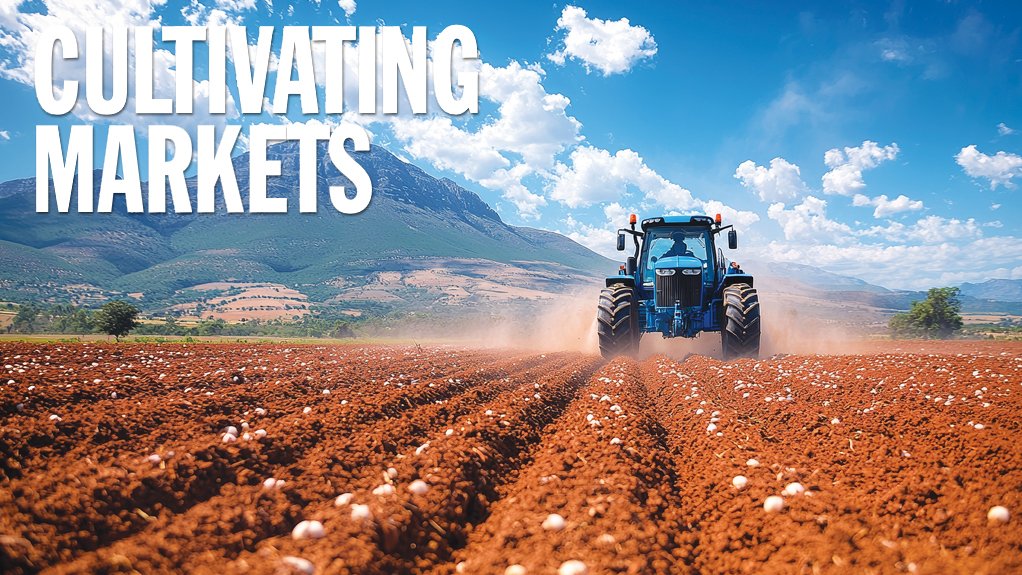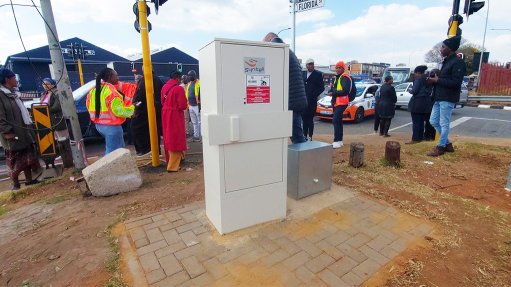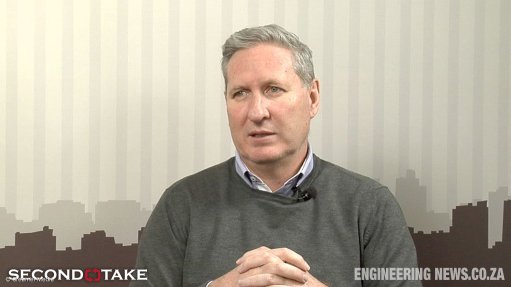SA’s ongoing agri growth now hinges on market diversification
South Africa’s agriculture sector has come under increasing pressure to diversify into new markets amid turbulent world market dynamics driven by radical shifts in US trade policy.
During a webinar hosted by Creamer Media on May 28, panel facilitator Professor Johann Kirsten, director of the Bureau for Economic Research at Stellenbosch University, noted that trade had become unstable in the global environment, and questioned whether a multi-polar world is replacing multilateralism.
However, this is not the first time the country’s agriculture sector has had to weather global turmoil. According to Agricultural Business Chamber chief economist Wandile Sihlobo, local producers have consistently demonstrated adaptability and agility.
He pointed out during the webinar that the sector has managed to double in volume and value terms since 1994, exporting $13.7-billion’s worth of goods last year, despite various global and local crises and challenges in the past three decades.
However, as half of what South Africa produces in value terms is exported, stakeholders need to remain mindful of trade dynamics, relationships and new opportunities.
Exports to the US, for example, account for between 4% and 6% of South Africa’s total exports and are concentrated in specific regions and commodities – particularly citrus, nuts, grapes and wine. While the US is by no means South Africa’s largest export market, it is still a vital market that supports producers in the horticulture industry.
The administration of US President Donald Trump earlier this year proposed a 30% punitive tariff on imports from South Africa, a move that would render them uncompetitive and effectively shut the US market to South African goods.
Bureau for Agriculture/Agricultural and Food Policy senior analyst and director Mmatlou Kalaba highlighted how South Africa’s agriculture sector has come into the spotlight, with President Cyril Ramaphosa having met with Trump in the US in May to dispel misconceptions about the sector.
South African stakeholders should take misconceptions about the sector on the global stage seriously and work to communicate with a unified voice to world markets.
Kalaba added that the imperative to diversify into more markets – which South Africa did relatively well – had always existed as a means of managing risk in agriculture. He cited the example of exports to other African countries, which had increased from 10% of total goods produced in 1994 to 40% of export production in 2024.
“Of course, this has largely been to countries in the Southern African Development Community region, and we can do more to unlock markets beyond this region,” he emphasised.
For Kalaba, the agriculture sector offers an untapped opportunity to export produce to East Asia, which has a growing population and rising incomes. However, this market is dominated by suppliers from South America, including from countries such as Peru, Venezuela, Brazil and Argentina, across both primary and secondary agriculture products.
“We are nowhere near our competitors in terms of market access in this region. One of the answers to our current situation is to diversify into East Asia and prioritise these trade relations.”
Kalaba is confident that the sector can negotiate new deals in this market, particularly since producers are already accustomed to complying with stringent EU standards for imports.
Sihlobo warned that protectionism was not limited to the US, citing the EU’s long- standing, stringent import requirements and Covid-19 having led to a reorientation in trade policy towards protectionism.
“The biggest lesson coming out of Trumpism is [that] we need to manage our risk better and try to get into all markets. I foresee many more protectionist policies coming to the fore over the next few years, including in BRICS countries, which already account for less than 10% of South Africa’s exports.
“Trade policy in South Africa should be friendly towards everyone,” he emphasised.
For Citrus Growers Association CEO Boitshoko Ntshabele, there is a need for more research, if agriculture is to remain competitive in a changing global market: “We need new tools to manage disease and biosecurity challenges and new solutions for increased yields.”
Kirsten agreed, pointing out that research, ultimately, informed farmers’ risk mitigation and productivity strategies. He believes South Africa’s research capabilities could be improved only through collaboration, especially since research on new seed varieties, for example, is a long-term process.
Mdaki stressed the importance of “moving with the times” and remaining cognisant of the needs of customers, including environmental preservation. For him, countries are increasingly considering where they import goods from and prefer trading partnerships with a lower carbon footprint in the value chain.
Case in Point
One of the sectors that would be particularly affected by a US 30% import tariff is citrus, of which exports comprise between 5% and 6%. While the number may appear small, Ntshabele said that the US market was vital to many rural communities, including in the Northern Cape, where citrus production forms the economic backbone of many towns.
Having had to navigate droughts, two world financial crises, logistics inefficiencies and phytosanitary discrimination in the EU, South Africa’s citrus industry still developed as one of the country’s top four export industries, despite not even ranking in the top ten in 1994.
Ntshabele highlighted the sector’s substantial investments in new irrigation technology, plantation expansion, plant breeders’ rights, and cold storage and other phytosanitary requirements – investments that have enabled yield increases from 30 t/ha to 60 t/ha.
He agrees with Kalaba that the agriculture sector has always had diversification of markets on the agenda to manage risk. However, this has now become more urgent and challenging – given issues with logistics in South Africa, a lack of infrastructure to export more into Africa and persistently high input costs.
The citrus sector, nonetheless, targets the export of 260-million 15 kg cartons by 2030.
For Ntshabele, the opportunity lies in negotiating with the 185 countries that are in talks with the US administration over tariffs. “What stops us from negotiating with each other?” he queried, adding that more effort could be made to remove non-tariff barriers and existing tariffs between South Africa and India, for example.
However, increased exports or exports to different markets would hinge on State- owned freight utility Transnet’s ability to operate efficiently. Ntshabele explained that while the utility’s inefficient port operations led to a R5.2-billion loss for the citrus industry in 2024, shipments were being quickly loaded and dispatched during the season so far this year.
Ntshabele, Sihlobo and Kalaba acknowledged the increased investment by Transnet to improve operational performance, including new equipment installations and streamlined, digitalised processes.
Gearing for New Markets
Transnet Port Terminals (TPT) CEO Jabu Mdaki affirmed that Transnet was not only replacing old equipment but also preparing for the future, including by become more weather resilient.
He cited the example of new technologies being developed for the ports of Cape Town, Gqeberha and East London so that equipment can operate in wind speeds of up to 90 km/h, compared with historical equipment’s limit of 70 km/h, which often necessitated the halting of port operations during higher wind speed periods.
In 2024/25, TPT lost three months of productivity, owing to high wind speeds, including 200 operational hours at the Port of Cape Town, when winds of up to 120 km/h left 12 vessels waiting at anchor.
TPT is working to reduce transport costs in South Africa for increased competitiveness. Costs currently amount to 11.2% of GDP in South Africa, compared with the US average of 8% of GDP, while 27% of South Africa’s GDP relies on efficient logistics for its sustainability, or R500-billion’s worth of primary industries and R735-billion’s worth of secondary industries.
To further improve turnaround times at the eight major seaports in the country, TPT introduced an incentive scheme for employees, aligned with productivity, in December last year.
“This has resulted in shipping line improvements and more incentives will be offered this year,” Mdaki said.
He added that TPT was investing in capacity to ensure that the new markets, if agricultural exports are to expand to new areas, can be serviced and catered for, including by streamlining procurement processes for new equipment and by ensuring that information, communication and technology systems are continuously modernised.
“The intention is to not only resolve logistics efficiency in South Africa but also have long-term, lasting solutions supported by private-sector partners,” Mdaki noted, referring to the notable efforts by the National Logistics Crisis Committee to improve efficiencies across the freight network through collaboration.
Sihlobo lauded Transnet for having facilitated South Africa’s record $13.7-billion exports in 2024, which could not have been possible had TPT not operated efficiently.
He is optimistic about TPT’s long-term focus, which will be necessary if the country meets its objectives of increasing agriculture output and diversifying into new markets.
The speakers agreed that, while there were massive opportunities to export more products into East Asia and the rest of the African continent, more investment in infrastructure, resilience, sustainability, productivity, biosecurity and competitiveness would be required as a joint effort involving all stakeholders in the industry.
Comments
Press Office
Announcements
What's On
Subscribe to improve your user experience...
Option 1 (equivalent of R125 a month):
Receive a weekly copy of Creamer Media's Engineering News & Mining Weekly magazine
(print copy for those in South Africa and e-magazine for those outside of South Africa)
Receive daily email newsletters
Access to full search results
Access archive of magazine back copies
Access to Projects in Progress
Access to ONE Research Report of your choice in PDF format
Option 2 (equivalent of R375 a month):
All benefits from Option 1
PLUS
Access to Creamer Media's Research Channel Africa for ALL Research Reports, in PDF format, on various industrial and mining sectors
including Electricity; Water; Energy Transition; Hydrogen; Roads, Rail and Ports; Coal; Gold; Platinum; Battery Metals; etc.
Already a subscriber?
Forgotten your password?
Receive weekly copy of Creamer Media's Engineering News & Mining Weekly magazine (print copy for those in South Africa and e-magazine for those outside of South Africa)
➕
Recieve daily email newsletters
➕
Access to full search results
➕
Access archive of magazine back copies
➕
Access to Projects in Progress
➕
Access to ONE Research Report of your choice in PDF format
RESEARCH CHANNEL AFRICA
R4500 (equivalent of R375 a month)
SUBSCRIBEAll benefits from Option 1
➕
Access to Creamer Media's Research Channel Africa for ALL Research Reports on various industrial and mining sectors, in PDF format, including on:
Electricity
➕
Water
➕
Energy Transition
➕
Hydrogen
➕
Roads, Rail and Ports
➕
Coal
➕
Gold
➕
Platinum
➕
Battery Metals
➕
etc.
Receive all benefits from Option 1 or Option 2 delivered to numerous people at your company
➕
Multiple User names and Passwords for simultaneous log-ins
➕
Intranet integration access to all in your organisation





















